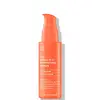What's inside
What's inside
 Key Ingredients
Key Ingredients

 Benefits
Benefits

 Concerns
Concerns

No concerns
 Ingredients Side-by-side
Ingredients Side-by-side

Methyl Trimethicone
Skin ConditioningCyclopentasiloxane
EmollientTrimethylsiloxysilicate
EmollientTetrahexyldecyl Ascorbate
AntioxidantDimethiconol
EmollientAscorbyl Glucoside
AntioxidantAscorbic Acid
AntioxidantArbutin
AntioxidantPhyllanthus Emblica Extract
Skin ConditioningAscorbic Acid/Orange/Citrus Limon/Citrus Aurantifolia Polypeptides
Skin ConditioningArctostaphylos Uva Ursi Leaf Extract
Skin ConditioningAscorbyl Palmitate
AntioxidantWater
Skin ConditioningMixed Terpenes
SolventPhospholipids
Skin ConditioningTocopheryl Acetate
AntioxidantRetinyl Palmitate
Skin ConditioningSuperoxide Dismutase
AntioxidantUbiquinone
AntioxidantPhenoxyethanol
PreservativeMethyl Trimethicone, Cyclopentasiloxane, Trimethylsiloxysilicate, Tetrahexyldecyl Ascorbate, Dimethiconol, Ascorbyl Glucoside, Ascorbic Acid, Arbutin, Phyllanthus Emblica Extract, Ascorbic Acid/Orange/Citrus Limon/Citrus Aurantifolia Polypeptides, Arctostaphylos Uva Ursi Leaf Extract, Ascorbyl Palmitate, Water, Mixed Terpenes, Phospholipids, Tocopheryl Acetate, Retinyl Palmitate, Superoxide Dismutase, Ubiquinone, Phenoxyethanol
Alternatives
Ingredients Explained
These ingredients are found in both products.
Ingredients higher up in an ingredient list are typically present in a larger amount.
Phenoxyethanol is a preservative that has germicide, antimicrobial, and aromatic properties. Studies show that phenoxyethanol can prevent microbial growth. By itself, it has a scent that is similar to that of a rose.
It's often used in formulations along with Caprylyl Glycol to preserve the shelf life of products.
Superoxide Dismutase is found in all living cells. This ingredient is AKA as 'SOD'.
SOD is a strong antioxidant. It protects living cells against oxidative damage by breaking down radical molecules into regular oxygen and hydrogen peroxide.
Antioxidants help fight free-radical molecules that may damage your skin's DNA. This may help with the signs of aging. Due to its antioxidant property, it is used to help treat chronic inflammation.
In cosmetics, SOD is usually obtained from marine phytoplankton, bovine liver, horseradish, cantaloupe, and certain bacteria.
The three major families of SOD include: Copper/Zinc, Iron/Manganese, and Nickel.
When eating SOD-rich foods, our bodies break it down into amino acids before absorption. Foods that contain SOD include: melons, citrus, spinach, broccoli, kale, almonds, sunflower seeds, and blue-green algae.
Learn more about Superoxide DismutaseTetrahexyldecyl Ascorbate (THD) is a stable and oil-soluble form of Vitamin C.
THD is special in that it has the ability to travel deeper into skin than traditional ascorbic acid while maintaining the same skin benefits (double win!).
Because it’s oil-soluble, THD dives deep into your skin’s fatty layers (think ceramides and cholesterol) to fight off the kind of free radicals that mess with your skin barrier. This makes it a great pair with water-based vitamin C (ascorbic acid) that mainly works on the surface.
Even at just 0.1%, THD is already showing great antioxidant activity. When used up to 2%, it helps keep your skin happy and calm, especially when it’s stressed from pollution or sun.
Want to fade dark spots or tackle hyperpigmentation? You’ll want 5% or more. Pairing it with brightening buddies like niacinamide or licorice root gives even better results. One study even used 30% THD with other brighteners and saw real results on stubborn discoloration, even in melasma-prone skin.
A note on THD: It’s has a slightly silky, oily texture and usually shows up colorless or pale yellow (though the exact shade can vary by supplier).
While you can sneak it into water-based formulas, it really shines when paired with silicones or oils, which help your skin soak it up better.
THD is pretty stable, but it’s still vulnerable to degradation like ascorbic acid. Too much light or heat (above 113°F / 45°C) can break it down over time. Go for dark and opaque packaging that keeps it safe and shady!
Read more about other types of Vitamin C:
Learn more about Tetrahexyldecyl Ascorbate